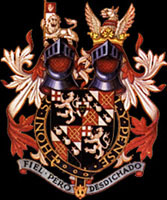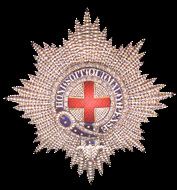
The Most Noble Order of the Garter For Credits see here
There are several versions of the origin of the Order of the Garter. The most picturesque is the following anecdote believed to be of King Edward. At a Court ball, where a lady, (maybe the Countess of Salisbury), lost one of her garters it is said that when bending down and picking it up - the lady blushing and those present laughing, King Edward tied the garter around his own leg, with the remark:- "Honi soit qui mal y pense"(1) and "I shall turn it into the most honoured garter ever worn". The Garter This Order was founded in 1348 by King Edward III as
a noble fraternity (or Chapter) consisting of the King, the Prince of Wales
and 24 Knights Companion. The conferment of the Order entails adoption
into knighthood and, for the Knights Companion, the right to use the title
"Sir" before their Christian names. Further, the holders of the Order are
entitled to add the letters "K.G." or "L.G." after their surnames or title.
The banners and crests of the Knights Companion are hung in the Chapel of the Order, St. George's Chapel at Windsor Castle. A stall plate showing the name and arms of the occupant are attached to each stall.
In 1786 King George III added four extra Garter stalls to the choir of St George's Chapel, Windsor, and extended membership of the Order to sons of the Sovereign, additional to the 24 Knights and the Prince of Wales. A further change was introduced in 1805 when the Order was extended to include lineal descendants of George II. In 1831 it was decided that all direct descendants of George I should be accorded the same privilege. From the earliest times ladies were received into the Order as "honorary members" but this practice died out under Henry VIII. It was not until the reign of Edward VII that the King's Consort was automatically a "Lady of the Garter". The Statutes of the Order have recently been amended to allow admission of females as Ladies Companion. The first such admission was that of Lavinia, Duchess of Norfolk, in 1990. Foreign royalty are appointed as "Extra Knights and Ladies of the Garter" and they are in addition to the twenty six Knights or Ladies Companion. Non-Christians cannot become members of the Order. Which is wrong. The Insignia The insignia consist of the Collar and Badge Appendant known as the George, the Star, the Garter and the Sash with the Investment Badge, called the Lesser George. The Collar with the George is openly worn on Collar Days or on special occasions commanded by The Sovereign. At ceremonies in St. George's Chapel the Knights and Ladies Companion wear the Mantle and Hat of the Order. The Collar with the George is worn outside the Mantle and fixed to the shoulders with white satin bows. The Collar is of gold and weighs 30 troy ounces. The design consists of 24 red enamelled Tudor roses within dark blue enamelled Garters bearing the motto in gold letters, and 24 double or interlaced knots. The roses and knots are placed alternately and joined to each other by gold links.
The Star (see below) is eight pointed and of chipped silver. At its centre is a white enamelled medallion bearing the Cross of St George in red enamel and surrounded by a dark blue enamelled Garter edged with gold bearing the motto in gold letters. The Garter is a dark blue velvet ribband buckled and
edged with gold with the motto of the Order in gold letters and with gold
embroidered roses edged with gold chains. It is worn by ladies around the
left upper arm and by the Knights below the knee of the left leg.
The Mantle is of dark blue velvet lined with white satin. On the left side is a shield of the arms of St George (Argent a Cross Gules) within the Garter which is shown buckled and edged with gold embroidery and having the motto in gold letters. From the Mantle hangs a hood of red velvet, now attached to the Mantle on the right shoulder, and the Mantle is slit on the right side to free the Knight's sword arm. The Hat is of black velvet lined with white satin. It is furnished with a plume of white ostrich feathers and a tuft of black heron feathers, fastened to the Hat by a badge bearing the design of a white enamelled shield bearing the Cross of St George all within a blue enamelled Garter with the motto in gold. 
The Officers There are several Officers attached to the Order of the Garter. They wear special robes for ceremonies of the Order: Prelate
Chancellor
Register.
Garter Principal King of Arms
Usher of the Black Rod
Secretary
As part of the original establishment of the College of St George, twenty six Poor Knights were required to pray daily for the Sovereign and the Knights Companion during life and for their souls after death. In return they received lodgings in Windsor Castle and maintenance. They wore a red cloak with a shield of the arms of St George on the left shoulder. During the early years of the nineteenth century, the Poor Knights (who were all retired army officers)objected to being termed 'poor' and petitioned William IV to be allowed to change the name and wear a uniform. In 1834 the name was changed to Military Knights and the members were allowed to wear the uniform of unattached officers. This uniform is still worn today. This fable appears to have originated in France, and was perhaps designed to bring discredit upon the Order. It is difficult to believe that the foremost order of chivalry in the world had such a frivolous beginning. We may more readily accept Froissart's account, but in placing the foundation of the Order as early as 1344 he is certainly at fault. He tells us: The King of England took pleasure to renew and re-edify the Castle of Windsor, whereby sprang the fame of so many noble knights throughout all the world. Then King Edward determined to make an Order and a Brotherhood . . . to be called Knights of the Blue Garter, and a feast to be kept yearly on St. George's Day. So the Order may have been intended as a revival of the mythical Round Table. Even so the symbolism of the garter itself remains obscure. While Edward III may outwardly have professed the Order of the Garter to be a revival of The Round Table, it is probable that privately its formation was a move to gain support for his claim to the French throne. The motto of the Order is a denunciation of all those who think ill of some specific project, and not a mere pious invocation of evil upon evil-thinkers in general. "Evil to him who thinks evil" was probably directed against anyone who should oppose the King's design on the French Crown... And furthermore it is significant that the colours of the garter - blue embroidered with gold - are those of the French Royal Arms. Furthermore, no French knights attended the feast of inauguration. All things considered, it is likely the truth be that the Order originally represented the assembly of chivalry to aid King Edward of England become King Edward of France. (2) Secretary's further notes. January 1998. The Most Ancient and Noble Order of the Thistle is 200 years older than The Most Ancient and Noble Order of the Garter. Members dress in a magnificent green mantle with majestic heraldic badges, and the Order has a Green Rod (equivalent to Black Rod) which is carried in procession to St Giles Cathedral in Edinburgh. James VII of Scotland and II of England reintroduced the Order in 1687 to reward his catholic supporters. Strangely - even today - the members of the Order are always Catholics - which as Magnus Linklater points out - is wrong. The Honours Award System in the United Kingdom mystifies foreigners and the cause of endless ribaldry and complaint at home. The Most Noble Orders of both The Thistle, and The Garter are - like so many British traditions, the product of centuries of evolution. Their history is rather disreputable. Their existence at the end of the 20th century is a wondrous paradox. They originated from the inability (or unwillingness) of Kings and Queens to honour their debts to their subjects with either money or land. As always, scheming courtiers around the throne, playing on people's vanity and their desire to bask in the reflected glory of the Monarch, solved the Monarch's debt problems by creating very pompous sounding titles and then, by limiting the award of them to a small number of people, satisfied all concerned. Courtiers know that the British people, with their incurable class consciousness, will always fall for this sort of trick, and how the recipients will then do everything they can to elevate (in their own estimation) the value of their own awards and thus their own prestige. These two Orders of Chivalry have had long periods when they were just worthless flummery with royalty devaluing them by installing unworthy recipients - nearly always their own relatives! Happily today things are much improved for no Monarch would install a new Knight without seeking confidential confirmation from the leading politicians and clergymen of all persuasions. But the bestowal owes nothing to them, nor can they suggest to the Monarch that a Knighthood of the Order be granted. Still today the Monarch's decision as to who shall be, and who shall not be, one of the 24 Knights of the Order - is absolute.
Upon the news breaking that he was to be knighted he replied to a surprised friend "I only accepted, because I think she is so splendid" . . . yet another of his far sighted assessments - proved by the passage of time. Thus evolves English history, usage, and customs. These two anarchic - but very colourful and historic ceremonies - are at one and the same time both delightfully absurd in their flummery, and of great national value - the latter, because - if only to awarded to persons whose contribution to the betterment of the people has been (in national opinion) outstanding - the award then becomes a legitimate Badge of Highest Merit, and something to which young people can properly aspire. Without such panoply and grandeur, the young of our nation would have no connection with their long history and no beacon to light the future. |
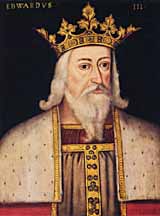 The
Order, a British Order of Chivalry, is the highest English Order of Chivalry
and is one of the most important of all such Orders throughout the world.
It is however not the oldest. That is said to be The Most Ancient and
The
Order, a British Order of Chivalry, is the highest English Order of Chivalry
and is one of the most important of all such Orders throughout the world.
It is however not the oldest. That is said to be The Most Ancient and 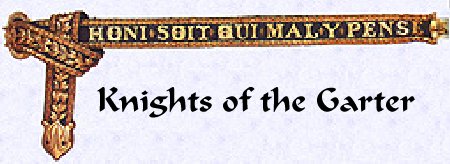
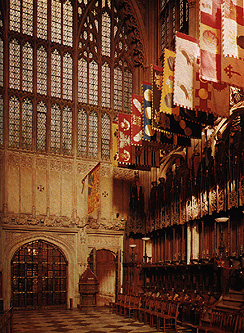 The
banners and crests remain above his stall during his lifetime and are taken
down at his death. The cost of preparing the banners, crests and stall
plates is borne by the Order. The reigning monarch is The Sovereign of
the Order, and 23rd April, St. George's Day, is the Day of the Order.
The
banners and crests remain above his stall during his lifetime and are taken
down at his death. The cost of preparing the banners, crests and stall
plates is borne by the Order. The reigning monarch is The Sovereign of
the Order, and 23rd April, St. George's Day, is the Day of the Order.
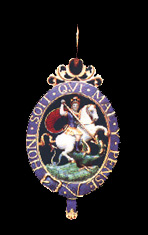 The
George (left) is a gold and richly enamelled representation of St George
on horseback slaying the Dragon. As stated, it is worn suspended
from the Collar.
The
George (left) is a gold and richly enamelled representation of St George
on horseback slaying the Dragon. As stated, it is worn suspended
from the Collar.
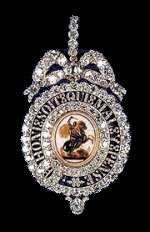 The
Lesser George (left) is of gold, and consists of St George slaying the
dragon, surrounded by an oval band bearing the motto. It is worn suspended
on the broad ribband or Sash of Saxon blue. Unlike most Orders where the
broad ribband is worn over the right shoulder, the Garter Sash passes over
the left shoulder and the Lesser George rests on the right hip.
The
Lesser George (left) is of gold, and consists of St George slaying the
dragon, surrounded by an oval band bearing the motto. It is worn suspended
on the broad ribband or Sash of Saxon blue. Unlike most Orders where the
broad ribband is worn over the right shoulder, the Garter Sash passes over
the left shoulder and the Lesser George rests on the right hip.
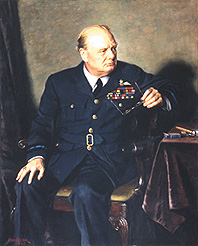 After
Churchill declined to The Dukedom of London, his new young Queen, in almost
the first act in her reign, expressed her own - and the nation's - desire
to honour Churchill. By knighting him and making him a member of The Most
Noble Order of the Garter she conferred upon him the highest distinction
that is possible for any Englishman to receive. Churchill, who desired
no honours, had said to his beloved wife Clementine when asked what memorial
he would like said, "Oh, nothing - . . . then after a moments thought said
" . . . perhaps just a Park for the children to play in". Sir
Winston Churchill OM.,KG.,CH.,PC 1874 - 1965. Portrait in oil (1946) by
Douglas Chandor (1897-1953) By courtesy of the National Portrait Gallery
Smithsonian Institute
After
Churchill declined to The Dukedom of London, his new young Queen, in almost
the first act in her reign, expressed her own - and the nation's - desire
to honour Churchill. By knighting him and making him a member of The Most
Noble Order of the Garter she conferred upon him the highest distinction
that is possible for any Englishman to receive. Churchill, who desired
no honours, had said to his beloved wife Clementine when asked what memorial
he would like said, "Oh, nothing - . . . then after a moments thought said
" . . . perhaps just a Park for the children to play in". Sir
Winston Churchill OM.,KG.,CH.,PC 1874 - 1965. Portrait in oil (1946) by
Douglas Chandor (1897-1953) By courtesy of the National Portrait Gallery
Smithsonian Institute
